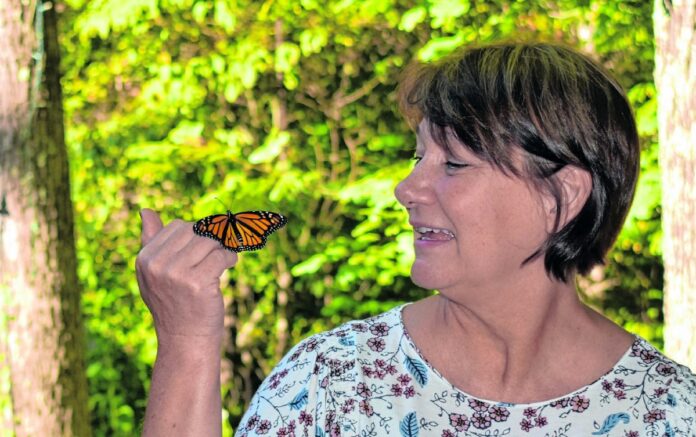

By DEBBIE KELLEY, guest columnist
I love monarchs. I raise them from tiny eggs to beautiful butterflies because their survival rate in the wild hovers around 1 percent.
My monarchs are tagged, tallied, reported and given a pep talk before they fly away to Mexico. They are like hundreds of kids that I raise every year in the hopes that my efforts will help these amazing insects survive for future generations.
Monarchs are important pollinators that travel 3,000 miles to and from Mexico, pollinating and laying eggs along the way. Monarchs are different from migrating birds because they only make the journey once, if at all. It takes three generations of monarchs to travel north, and the fourth generation travels south to a small, isolated overwintering location in Mexico.
If that does not seem challenging enough, monarch caterpillars have only one food source: milkweed. If monarch butterflies cannot find milkweed along this perilous journey, they cannot lay their eggs and the next generation is lost.
This year, only two monarchs have reached my home pollinator habitat.
According to National Wildlife Federation (NWF), eastern monarch butterfly populations have declined 90 percent from their high in 1969. The reductions have been so dramatic, monarchs now meet the criteria to be listed under the Endangered Species Act. As milkweed and natural habitat are removed to make way for roads, farming and housing, the number of migrating monarchs continues to decline.
Although fewer monarchs might be more noticeable, there are also fewer bees, songbirds and other wildlife because the monarch breeding habitat is one they share with all pollinators.
Monarch Joint Venture, a nonprofit devoted to protecting monarchs and their migration, consider monarchs to be the proverbial “canary in the coal mine.” The loss of habitat sets off a chain reaction as food sources suffer for pollinators and birds, and eventually impacts our food systems.
Pollinators help create 1 out of every 3 bites of food we eat. Pollinators, birds, wildlife — our health is tied to theirs. We are all connected, and restoring their habitat is an essential first step.
According to Indiana’s State Wildlife Action Plan, nearly 100,000 acres of Indiana habitat was lost between 2001 and 2011. The nonprofit Indiana Wildlife Federation is leading Indiana’s monarch conservation efforts, although there are many organizations working to restore the habitat. According to Brianne Lowe of NWF, these programs have added nearly 90 acres of habitat each year across Indiana.
You can help step up those efforts if, together, we create 100 acres of monarch habitat right here in Brown County.
There are three main requirements to create a monarch breeding habitat.
One, plant milkweed. Not too difficult with easy-to-make milkweed seed bombs that can be tossed into fields in late fall. St. David’s Episcopal Church’s Pollinator Day Camp on July 15 made them, and you can too.
Two, protect the land from pesticides. Chose not to spray pesticides on your land. You cannot prevent your neighbor from spraying, but you can share the impact it has on pollinators, and they may make a different choice.
Third, practice strategic mowing. Mowing a portion of your habitat in June may provide fresher, more appealing milkweed during Indiana’s peak September monarch migration. Mowing after mid-July though could destroy crucial milkweed and the caterpillars feeding on it.
Three simple steps, and vital monarch habitats can be added that all pollinators will appreciate.
This quest has started with several excellent partners: Purdue Extension — Brown County, Indiana Wildlife Federation, Brown County Soil & Water Conservation District, and St. David’s Episcopal Church who will help us with supplies, education and expertise.
Jorge Rickards, director general of World Wildlife Fund of Mexico, said, “Monarch butterflies show us how individual work, in this case, migration, can become an exceptional collaborative exercise.”
One hundred acres for our pollinators can be our exceptional collaborative exercise and a thank-you for all pollinators do for us every day.
To learn more, create a habitat or volunteer to plant milkweed, you can visit http:rowncountypollinators.com or visit the “Ask A Gardener” table in the Exhibit Hall at the Brown County Fair July 27 or July 29. We’ll provide tips and guidance about monarch habitat, and you can pick up common milkweed seed packets.
We have 20 acres of land pledged for monarch habitat in Brown County so far. Please join us and help us reach 100 acres over the coming year and encourage other Indiana counties to do the same.

Debbie Kelley is a Brown County resident and Master Gardener. Look for her pollinators booth at the Exhibit Building at the Brown County 4-H Fair the week of July 26.
[sc:pullout-title pullout-title=”Make milkweed seed bombs” ][sc:pullout-text-begin]
A “seed bomb” is a small ball made of clay, soil, compost and seeds. They can be placed on the ground or tossed into a hard-to-reach area, and when the conditions are right, they will sprout. New plants will grow, where there were previously none.
Ingredients:
- Cheap, unscented clay kitty litter (Bentonite clay)
- Seed starter mix or lightened potting soil
- Common milkweed seeds (other seeds can be added)
- Water
Instructions: Combine 5 parts kitty litter and 1 part soil and add a little water at a time until the mixture makes a mud patty dough. Add seven to 10 seeds to the middle and form your dough into balls. Let the balls dry for a few days in a well-ventilated area. When dry, store them in a cool, dry, dark place. They will keep indefinitely stored this way, as long as there is no moisture to activate them. When you are ready, place or throw them into the habitat area. Since common milkweed need cold stratification, it is best to toss them in the late fall after a frost. Then, let nature handle the rest!
[sc:pullout-text-end]



